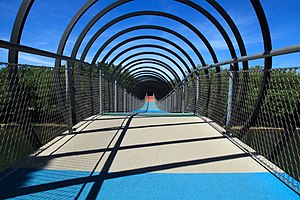Slinky springs to fame
| Slinky springs to fame | ||
|---|---|---|
| use | footbridge | |
| Crossing of | Rhine-Herne Canal | |
| location | Oberhausen | |
| construction | Tension band bridge | |
| overall length | 406 m | |
| broad | 2.67 m | |
| Longest span | 66 m | |
| start of building | December 2009 | |
| completion | June 2011 | |
| planner |
Tobias Rehberger (design), Schlaich Bergermann Partner (structure) |
|
| position | ||
| Coordinates | 51 ° 29 '35 " N , 6 ° 51' 30" E | |
|
|
||

Slinky springs to fame (also Rehberger Bridge ) is the name of a pedestrian bridge over the Rhine-Herne Canal at canal kilometer 8,596, which connects the Kaisergarten in Oberhausen with the sports park opposite on Lindnerstrasse and the adjoining landscape of the Emscher .
Rehberger was inspired by Slinky , a toy made of a coil spring . The English title of the bridge was translated as "Slinky jumps to glory" or "Slinky feathers to glory" .
Contribution to the EMSCHERKUNST. 2010 project
The bridge designed by the artist Tobias Rehberger in close cooperation with the engineering office Schlaich Bergermann Partner as a walkable sculpture was a contribution to the EMSCHERKUNST.2010 project of the European Capital of Culture RUHR.2010 . It resembles a colored, winding and curved ribbon that is wrapped in a light, swaying spiral . The bridge ramps run in irregular loops through the parks on both banks.
Framework conditions of the project
When working out the draft, the clearance height of 8 m specified by the Waterways and Shipping Authority had to be adhered to. Since the canal bank is secured by sheet pile walls anchored to the rear and various supply lines are laid next to the bank paths, the bank strips were not allowed to be built on. The conditions of the competition stipulated that the bridge would be free of obstacles and suitable for the handicapped, and that the old trees would be preserved.
The helix, the essential element of the artistic design, could not be the supporting structure of the bridge; it would have become much too bulky and heavy for the intended light and lively bridge sculpture. It was therefore decided to make the colored tape the load-bearing element.
description
The total of 406 m long bridge is a tension band bridge with two sheet metal bands made of high-strength steel, which are guided over slim 10 m high V-shaped steel supports and anchored in the ground with 4 vertical tie rods on each side. The metal strips are 46 cm wide and 3 cm thick. The span between the supports is 66 m, the distance between the two supports of the V-supports is 20 m each.
On the two bands, 2.67 m wide and 12 cm thick concrete slabs are mounted, which have a colored surface similar to the tartan tracks on sports fields, which includes 16 different shades. The edges and the undersides of the panels are each of the same color. The railing posts made of steel tubes and the rings of the helix made of a hollow aluminum profile are mounted on the concrete slabs. The helix could be held very easily because it has no load-bearing function. It has a diameter of around 5 m. Tension band bridges are susceptible to vibrations. The damping properties of the cable net railings and the resilient covering were used to dampen their vibrations. Complex dynamic calculations and wind tunnel studies were carried out during the construction of the bridge.
The bridge ramps have a constant slope of 6%. Because of the different terrain levels, the southern bridge ramp above the Kaisergarten is 170 m long, the opposite only 130 m long. They have a 25 cm thick continuous beam made of concrete, which is supported about every 10 m on slim tubular steel supports arranged in pairs.
At night, the 293 LED lights built into the coils illuminate the colored roadway from below and LED lights in the handrails of the railings illuminate the walking area from above.
The bridge is often referred to as a pedestrian and cyclist bridge, but the traffic signs at both ends make it reserved for pedestrians.
The construction was commissioned by the Emschergenossenschaft as the client and began in December 2009. The bridge was opened on June 25, 2011.
Awards
- Steel Innovation Award 2012
- ECCS Award for steel bridges 2012, Certificate of Merit
- Footbridge Awards 2014, medium span category, commendation ("highly commended")
Web links
- Mike Schlaich: Slinky springs to fame - Oberhausen. Explanatory report on the submission to the German Steel Construction Engineering Award 2013, on bauforumstahl.de
Individual evidence
-
↑ Tobias Rehberger: Slinky Springs to Fame - Oberhausen. In: Westart masterpieces from May 15, 2012, from 3:45 min.
Rehberger Bridge. In: oberhausen.de
Slinky Springs to Fame. In: oberhausen.de
All about Oberhausen Castle. In: ruhrgebiet-industriekultur.de
Rehberger Bridge “Slinky Springs to Fame”. In: oberhausen-tourismus.de - ↑ Tobias Rehberger, Slinky springs to fame, Oberhausen. In: ruhrkunstmuseen.com
- ^ Springy fame: The Oberhausen Rehberger Bridge at night . In: Westdeutsche Allgemeine Zeitung of July 8, 2011.
- ↑ Rehberger Bridge "Slinky Springs to Fame" on oberhausen-tourismus.de
- ↑ a b c bridge sculpture "Slinky springs to fame" on sbp.de (Schlaich Bergermann Partner)
- ^ Mike Schlaich: Slinky springs to fame - Oberhausen. Explanatory report on the submission to the German Steel Construction Engineering Award 2013, on bauforumstahl.de
- ↑ The term spiral bridge was invented by the local media.
- ↑ Steel innovation award for "Slinky springs to fame". In: Category Components and Systems made of Steel for Building, Steel Innovation Award 2012, Steel Information Center.



